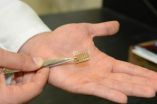(Press-News.org) Stanford University scientists have built the first solar cell made entirely of carbon, a promising alternative to the expensive materials used in photovoltaic devices today.
The results are published in the Oct. 31 online edition of the journal ACS Nano.
"Carbon has the potential to deliver high performance at a low cost," said study senior author Zhenan Bao, a professor of chemical engineering at Stanford. "To the best of our knowledge, this is the first demonstration of a working solar cell that has all of the components made of carbon. This study builds on previous work done in our lab."
Unlike rigid silicon solar panels that adorn many rooftops, Stanford's thin film prototype is made of carbon materials that can be coated from solution. "Perhaps in the future we can look at alternative markets where flexible carbon solar cells are coated on the surface of buildings, on windows or on cars to generate electricity," Bao said.
The coating technique also has the potential to reduce manufacturing costs, said Stanford graduate student Michael Vosgueritchian, co-lead author of the study with postdoctoral researcher Marc Ramuz.
"Processing silicon-based solar cells requires a lot of steps," Vosgueritchian explained. "But our entire device can be built using simple coating methods that don't require expensive tools and machines."
Carbon nanomaterials
The Bao group's experimental solar cell consists of a photoactive layer, which absorbs sunlight, sandwiched between two electrodes. In a typical thin film solar cell, the electrodes are made of conductive metals and indium tin oxide (ITO). "Materials like indium are scarce and becoming more expensive as the demand for solar cells, touchscreen panels and other electronic devices grows," Bao said. "Carbon, on the other hand, is low cost and Earth-abundant."
For the study, Bao and her colleagues replaced the silver and ITO used in conventional electrodes with graphene – sheets of carbon that are one atom thick –and single-walled carbon nanotubes that are 10,000 times narrower than a human hair. "Carbon nanotubes have extraordinary electrical conductivity and light-absorption properties," Bao said.
For the active layer, the scientists used material made of carbon nanotubes and "buckyballs" – soccer ball-shaped carbon molecules just one nanometer in diameter. The research team recently filed a patent for the entire device.
"Every component in our solar cell, from top to bottom, is made of carbon materials," Vosgueritchian said. "Other groups have reported making all-carbon solar cells, but they were referring to just the active layer in the middle, not the electrodes."
One drawback of the all-carbon prototype is that it primarily absorbs near-infrared wavelengths of light, contributing to a laboratory efficiency of less than 1 percent – much lower than commercially available solar cells. "We clearly have a long way to go on efficiency," Bao said. "But with better materials and better processing techniques, we expect that the efficiency will go up quite dramatically."
Improving efficiency
The Stanford team is looking at a variety of ways to improve efficiency. "Roughness can short-circuit the device and make it hard to collect the current," Bao said. "We have to figure out how to make each layer very smooth by stacking the nanomaterials really well."
The researchers are also experimenting with carbon nanomaterials that can absorb more light in a broader range of wavelengths, including the visible spectrum.
"Materials made of carbon are very robust," Bao said. "They remain stable in air temperatures of nearly 1,100 degrees Fahrenheit."
The ability of carbon solar cells to out-perform conventional devices under extreme conditions could overcome the need for greater efficiency, according to Vosgueritchian. "We believe that all-carbon solar cells could be used in extreme environments, such as at high temperatures or at high physical stress," he said. "But obviously we want the highest efficiency possible and are working on ways to improve our device."
"Photovoltaics will definitely be a very important source of power that we will tap into in the future," Bao said. "We have a lot of available sunlight. We've got to figure out some way to use this natural resource that is given to us."
INFORMATION:
Other authors of the study are Peng Wei of Stanford and Chenggong Wang and Yongli Gao of the University of Rochester Department of Physics and Astronomy. The research was funded by the Global Climate and Energy Project at Stanford and the Air Force Office for Scientific Research.
This article was written by Mark Shwartz of the Precourt Institute for Energy at Stanford University.
Stanford scientists build the first all-carbon solar cell
2012-10-31
ELSE PRESS RELEASES FROM THIS DATE:
Clinical hypnosis can reduce hot flashes after menopause, Baylor study shows
2012-10-31
Clinical hypnosis can effectively reduce hot flashes and associated symptoms among postmenopausal women, according to a new study conducted by researchers at Baylor University's Mind-Body Medicine Research Laboratory.
Hypnotic relaxation therapy reduced hot flashes by as much as 80 percent, and the findings also showed participants experienced improved quality of life and a lessening of anxiety and depression.
The mind-body therapy study of 187 women over a five-week period measured both physical symptoms of hot flashes and women's self-reporting of flashes. The women ...
Scientists find aphid resistance in black raspberry
2012-10-31
There's good news for fans of black raspberries: A U.S. Department of Agriculture (USDA) scientist and his commercial colleague have found black raspberries that have resistance to a disease-spreading aphid.
Agricultural Research Service (ARS) horticulturist Chad Finn with the agency's Horticultural Crops Research Unit in Corvallis, Ore., and colleague Michael Dossett of Agriculture and Agri-Food Canada are the first to find and report black raspberry resistance to the large raspberry aphid.
ARS is USDA's chief intramural scientific research agency, and this research ...
Green tea found to reduce rate of some GI cancers
2012-10-31
Women who drink green tea may lower their risk of developing some digestive system cancers, especially cancers of the stomach/esophagus and colorectum, according to a study led by researchers from Vanderbilt-Ingram Cancer Center.
The study by lead author Sarah Nechuta, Ph.D., MPH, assistant professor of Medicine, was published online in advance of the Nov. 1 edition of the American Journal of Clinical Nutrition. Wei Zheng, M.D., Ph.D., MPH, professor of Medicine, chief of the Division of Epidemiology and director of the Vanderbilt Epidemiology Center, was the principal ...
Medicare: Barrier to hospice increases hospitalization
2012-10-31
PROVIDENCE, R.I. [Brown University] — A Medicare rule that blocks thousands of nursing home residents from receiving simultaneous reimbursement for hospice and skilled nursing facility (SNF) care at the end of life may result in those residents receiving more aggressive treatment and hospitalization, according a new analysis.
"This study is the first, to the knowledge of the authors, to attempt to understand how treatments and outcomes vary for nursing home residents with advanced dementia who use Medicare SNF care near the end of life and who do or do not enroll in Medicare ...
Fat molecule ceramide may factor in muscle loss in older adults
2012-10-31
As men and women age, increasing quantities of fat tissue inevitably take up residence in skeletal muscle. A small study of older and younger men conducted at the Jean Mayer USDA Human Nutrition Research Center on Aging at Tufts University suggests that a build-up of a fat molecule known as ceramide might play a leading role in muscle deterioration in older adults. The results of the study were published online this month by the Journal of Applied Physiology, a publication of the American Physiological Society.
The study enrolled ten 10 men in their mid-seventies to ...
Guidelines developed for extremely premature infants at NCH proven to be life-changing
2012-10-31
VIDEO:
For the last decade, prematurity has been the leading cause of infant mortality in the US. As a result of prematurity, many infants enter this world too early with a...
Click here for more information.
For the last decade, prematurity has been the leading cause of infant mortality in the United States. As a result of prematurity many infants enter this world too early with a small chance of survival. In order to help treat these extremely premature infants, physicians ...
Confirmation of nitisinone efficacy for life-threatening liver disease
2012-10-31
A consortium of Quebec researchers coordinated by the Medical Genetics Service of the Sainte-Justine UHC has just published the findings of a 25-year study on the treatment of tyrosinemia, a life-threatening liver disease of genetic origin, which is screened at birth in the province of Quebec, where it is much more frequent than anywhere else in the world. "After five years of treatment, no trace of the disease can be detected in the liver of newborns who were treated with nitisinone starting from the first month of life," states Dr. Grant Mitchell of the Sainte-Justine ...
The controversy over flame retardants in millions of sofas, chairs and other products
2012-10-31
Flame retardants in the polyurethane foam of millions of upholstered sofas, overstuffed chairs and other products have ignited a heated debate over safety, efficacy and fire-safety standards -- and a search for alternative materials. That's the topic of a cover story package in the current edition of Chemical & Engineering News (C&EN), the weekly newsmagazine of ACS, the world's largest scientific society.
An overview of the package describes the controversy, fostered largely by a California chemist, who claims that flame retardants pose unacceptable toxic hazards and ...
A heady discovery for beer fans: The first gene for beer foam could improve froth
2012-10-31
The yeast used to make beer has yielded what may be the first gene for beer foam, scientists are reporting in a new study. Published in ACS' Journal of Agricultural and Food Chemistry, the discovery opens the door to new possibilities for improving the frothy "head" so critical to the aroma and eye appeal of the world's favorite alcoholic beverage, they say.
Tomás G. Villa and colleagues explain that proteins from the barley and yeast used to make beer contribute to the quality of its foam. The foamy head consists of bubbles containing carbon dioxide gas, which yeast ...
New micropumps for hand-held medical labs produce pressures 500 times higher than car tire
2012-10-31
In an advance toward analyzing blood and urine instantly at a patient's bedside instead of waiting for results from a central laboratory, scientists are reporting development of a new micropump capable of producing pressures almost 500 times higher than the pressure in a car tire. Described in ACS' journal Analytical Chemistry, the pumps are for futuristic "labs-on-a-chip," which reduce entire laboratories to the size of a postage stamp.
Shaorong Liu and colleagues explain that powerful pumps are critical for high performance liquid chromatography (HPLC), a mainstay laboratory ...

